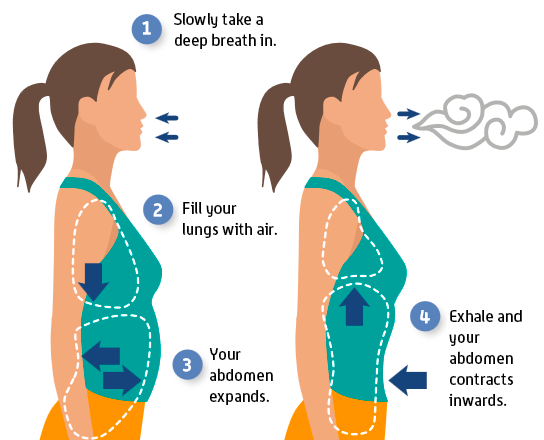Vous avez du mal à respirer en courant ? Voici comment y remédier
Respirer est un réflexe, mais en course à pied, une respiration efficace devient essentielle. Avoir du mal à reprendre son souffle peut ralentir votre allure, limiter votre endurance et rendre votre course plus difficile qu'elle ne devrait l'être. La bonne nouvelle, c'est qu'il est possible d'améliorer sa respiration en courant, tout comme on entraîne ses muscles.

Vous trouverez ci-dessous des conseils et des techniques scientifiquement validés pour vous aider à mieux respirer pendant la course, à améliorer vos performances et à rester à l'aise quel que soit votre rythme ou la distance parcourue.
Pratiquer la respiration abdominale
Aussi appelée respiration diaphragmatique, la respiration abdominale est une technique qui consiste à solliciter consciemment son diaphragme (le grand muscle situé sous les poumons) pour inspirer plus profondément. Cela permet d'optimiser l'apport en oxygène et de réduire la respiration superficielle, basée sur la poitrine, qui peut engendrer fatigue et anxiété pendant une course.
Comment procéder :
Allongez-vous sur le dos, une main sur la poitrine et l'autre sur le ventre. Inspirez lentement par le nez en vous concentrant sur le gonflement de votre ventre plutôt que de votre poitrine. Puis expirez lentement. Une fois que vous maîtrisez cet exercice en position allongée, entraînez-vous debout, en marchant, et enfin en courant.

Pourquoi c'est important :
La respiration abdominale augmente l'apport d'oxygène aux muscles à chaque inspiration. Elle favorise également l'élimination du dioxyde de carbone de l'organisme.<sup>1</sup> La respiration abdominale peut vous aider à courir plus loin et plus efficacement, à améliorer votre stabilité centrale et vos performances en course à pied.
Respirez de façon rythmique
La respiration rythmique consiste à synchroniser sa respiration avec ses pas. Cette technique permet de mieux répartir l'impact de la course entre les deux côtés du corps et d'améliorer l'oxygénation.
Les schémas courants comprennent :
Rythme respiratoire 3:2 (inspirer pendant 3 pas, expirer pendant 2) : Souvent utilisé pour les allures modérées.
Motif 2:2 : Fréquent lors des passages à tempo rapide.
Modèle 2:1 ou 1:1 : généralement utilisé lors des intervalles de haute intensité.
Selon Budd Coates, entraîneur de course à pied et auteur de « Running on Air », la respiration rythmique peut réduire la tension exercée sur le diaphragme et même aider à prévenir les points de côté.
Savoir quand respirer par le nez plutôt que par la bouche
Les coureurs débattent de la question de savoir s'il vaut mieux respirer par le nez ou par la bouche. La réponse courte est : cela dépend de votre vitesse de course.
La respiration nasale est idéale pour les échauffements, les étirements et les courses légères. Elle permet de purifier et de réchauffer l'air, ce qui le rend plus supportable pour les poumons.
La respiration buccale est nécessaire lors d'un exercice intense, lorsque votre corps a besoin de plus d'oxygène que votre nez ne peut en fournir.
Certains athlètes s'entraînent à respirer par le nez pour améliorer leur endurance et s'habituer au dioxyde de carbone. Cependant, pour la plupart des coureurs, passer à la respiration buccale lors d'entraînements intensifs est normal et souvent recommandé.
Exercices de respiration pour améliorer votre course à pied
Il est utile de pratiquer des exercices de respiration en dehors de vos séances de course à pied afin d'apprendre la bonne technique et de renforcer votre diaphragme. Vous pouvez également utiliser certains exercices de respiration comme échauffement avant vos entraînements.
Respiration abdominale
Pour apprendre la respiration abdominale, entraînez-vous au repos avant d'essayer de la pratiquer en courant. Suivez ces étapes :
- Allongez-vous sur le dos.
- Posez une main sur votre poitrine et l'autre sur votre ventre.
- Inspirez par le nez en gonflant votre ventre d'air. La main posée sur votre poitrine doit rester immobile, mais celle posée sur votre ventre doit se soulever au rythme de votre inspiration.
- Expirez lentement en pinçant les lèvres, comme si vous souffliez une bougie.
Une fois que vous parvenez à respirer confortablement par le ventre en position couchée, essayez en position assise, puis passez à la position debout, à la marche et, enfin, à la course.
Mini apnées
Les mini-apnées sont un exercice simple qui renforce le diaphragme. Lorsque vous retenez votre respiration, vous ressentez un besoin intense de respirer, ce qui stimule davantage votre diaphragme et le rend plus fort.
Effectuez cet exercice lorsque vous êtes détendu ou en guise d'échauffement avant de courir.
Retenez votre respiration jusqu'à ressentir un besoin impérieux de respirer, ce qu'on appelle la sensation de manque d'air. Puis, respirez à nouveau, mais calmement.
Respirez par le nez pendant 2 à 3 minutes, puis retenez votre respiration.
Répétez ce processus 3 à 5 fois.
Les apnées de courte durée peuvent provoquer de légers maux de tête ou des étourdissements. Si vous avez des problèmes de santé, notamment cardiaques ou pulmonaires, veuillez consulter un professionnel de la santé avant d'essayer ces exercices.
Respiration à lèvres pincées
Inspirez par le nez, puis expirez lentement par la bouche fermée, comme si vous souffliez une bougie. Cet exercice permet de respirer plus lentement, d'oxygéner davantage ses membres et est idéal pour la récupération après l'effort ou pour les coureurs asthmatiques.

Une étude de 2020 publiée dans l'American Journal of Respiratory and Critical Care Medicine a montré que la respiration à lèvres pincées peut aider à réduire l'essoufflement et à améliorer l'efficacité de la ventilation chez les athlètes et les patients souffrant de problèmes respiratoires.
Respiration rythmique
Essayez d'intégrer des exercices de respiration rythmée à vos échauffements et à vos étirements. Commencez par un rythme de 3:3 et passez progressivement à 2:2 ou 2:1 à mesure que l'intensité augmente. Pratiquer en dehors d'une course complète vous permettra d'adopter ce rythme plus naturellement une fois que vous aurez atteint votre allure de compétition.
Comment respirer à différentes intensités
Courses faciles : Essayez de respirer par le nez pendant vos courses faciles. Cela vous permettra de respirer plus lentement et d’augmenter votre amplitude de mouvement.
Courses à allure soutenue : Pour les courses à allure soutenue, pratiquez une respiration régulière adaptée à votre rythme.
Courir en montée ou faire un sprint : Lorsque vous courez en montée ou faites un sprint, vous devrez peut-être respirer par la bouche pour fournir l'oxygène nécessaire à vos muscles.

Pour mieux gérer votre respiration et votre effort à différentes intensités, utilisez un moniteur de fréquence cardiaque comme le Moniteur de fréquence cardiaque Coospo Cela peut vous aider. En surveillant vos zones de fréquence cardiaque en temps réel, vous saurez précisément à quelle intensité vous vous entraînez : effort aérobie léger, effort au seuil ou effort de haute intensité. Vous pourrez ainsi adapter plus facilement votre respiration à votre niveau d’effort et améliorer votre efficacité globale.
Erreurs respiratoires courantes à éviter
Même les coureurs expérimentés peuvent adopter des schémas respiratoires inefficaces. Voici quelques pièges courants :
- Respiration thoracique superficielleUtiliser uniquement la partie supérieure de la poitrine limite l'apport en oxygène et peut entraîner de la fatigue. Privilégiez la respiration diaphragmatique pour des inspirations plus profondes et plus amples.
- Retenir sa respirationCela peut se produire lors de montées ou de sprints, en cas de concentration intense. Expirez consciemment pour rester détendu et éviter l'accumulation de dioxyde de carbone.
- Respiration asymétriqueExpirer systématiquement en commençant par le même pied peut provoquer un déséquilibre et des tensions. Pratiquez une respiration rythmée pour répartir l'impact uniformément.
- Ignorer les signaux de détresseDes signes comme des halètements, des étourdissements ou une respiration sifflante indiquent qu'il est temps de ralentir ou de s'arrêter. La respiration doit être un effort, mais pas une source de panique.
Quand devriez-vous demander conseil à un professionnel ?
Les difficultés respiratoires pendant la course sont fréquentes, mais elles peuvent parfois révéler un problème sous-jacent nécessitant une prise en charge médicale. Consultez un professionnel de santé ou un pneumologue du sport si vous ressentez les symptômes suivants :
Essoufflement persistant même à faible intensité
Respiration sifflante ou sensation d'oppression dans la poitrine
Fatigue inhabituelle non expliquée par l'entraînement
Toux fréquente pendant ou après la course
L'évaluation peut comprendre une spirométrie, un test de VO₂ max ou d'autres examens respiratoires. Plus tôt vous traiterez ces problèmes, meilleures seront vos chances d'améliorer votre confort et vos performances.











